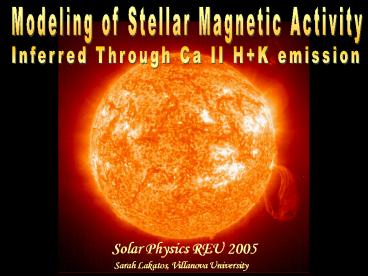Inferred Through Ca II H K emission - PowerPoint PPT Presentation
1 / 22
Title:
Inferred Through Ca II H K emission
Description:
To create a subset of stars with similar properties to the sun, with a wide ... on the 100in Telescope, using a two channel Photometer and the 1.5m telescope. ... – PowerPoint PPT presentation
Number of Views:77
Avg rating:3.0/5.0
Title: Inferred Through Ca II H K emission
1
Modeling of Stellar Magnetic Activity
Inferred Through Ca II HK emission
Solar Physics REU 2005
Sarah Lakatos, Villanova University
2
Objectives
- To create a subset of stars with similar
properties to the sun, with a wide range of ages - To look at the Ca II HK emission data and see
how the stars emission changes with age - To compare the x-ray data to that of the Ca II
HK - To determine and use the relationships between
the stellar parameters to help understand the
evolution of the dynamo from a younger sun to an
older sun
3
http//earth.ast.smith.edu/courses/ast224/ColorMag
nitude.htm
http//www.enchantedlearning.com/subjects/astronom
y/stars/startypes.shtml
4
Background Info.
- Dynamo Cycle of Stars
- A stars magnetic dynamo is governed by many
parameters. - Most important are the depth of the Convection
Zone, the Rotation Period, and t(c) - As the star ages it spins down due to the loss
of angular momentum through the outflow of
magnetized stellar winds
ds9.ssl.berkeley.edu/.../ 6/images_6/sun_350.jpg
5
Background Info. Cont.
- This spin down effects the amount of magnetic
field activity - By studying the Ca II HK data and x-ray
emission which is caused by magnetically mediated
heating we can determine how the activity depends
on various stellar parameters and evolves with
age.
Mt. Wilson 100in Telescope ROSAT satellite
6
Mt. Wilson Ca II HK Project
Ca II K line
http//www.mtwilson.edu/hk/Overview/
- Sun like stars show strong absorption lines from
singly ionized calcium (Ca II) - These important lines were named by Joesph von
Fraunhofer, and are found in the near-UV at 3969
Å (H) and 3934 Å (K)
Ca II H line
7
Mt. Wilson Data
- Measurements were taken on the 100in Telescope,
using a two channel Photometer and the 1.5m
telescope. - Measured the variations of the Ca II H and K
lines (chromospheric activity) over at total of
25 years, to help determine the Magnetic Activity
Cycle. - The cycles are classified as, excellent, good,
fair, poor, variable, or flat. - The S index was used to graph the Ca II HK data
vs. Age for the program stars.
Baliunas et. al. 1995ApJ...438..269B
8
Magnetic Dynamo of the Sun
- Two Magnetic Fields
Pictures from www-solar.mcs.st-andrews.ac.uk/...
/ gif/mlast.gif
Omega Effect Differential Rotation
lt-----------------------
Poloidal Field
Toroidal Field
Dynamo Cycle
lt-----------------------
Helical turbulence and Coriolis Force Alpha Effect
9
Magnetic Dynamo Equations
Equation for Toroidal field
Bf stands for Toroidal field A stands for
Poloidal field ?? / L stands for the differential
rotation, or sheer (how fast the rotation is
changing) ? stands for the diffusivity
Equation for Poloidal field
a stands for the alpha effect
10
Magnetic Dynamo Equations
Dynamo Number Equation
- Dynamo is the ratio of the source term to the
sink term in the dynamo equations.
Diffusivity Equation
- L length of the convection zone
- tc convective turnover time
11
Magnetic Dynamo Equations
Ro Prot
tc
Rossby Number Equation
Prot 2p/O tc L2/?
- sub in the ? equation into the ND equation
- assume the differential rotation is proportional
to the rotation rate, which is inversely
proportional to the period of rotation. - ?? a O Prot a 1/ O
- with these substitutions you get the relation
below
Dynamo related to Ro
12
Chart of Program Stars
13
Chart Continued
14
Teff, Radius, Mass Graphs
15
Finding Ages
Log Prot 0.658log T 1.0152 Prot
10.36T0.658
Correlation 0.976617 Confidence 1.08784x10-8
99.99
Correlation 0.9948870 Confidence 1.88358x10-39
99.99
Prot is directly proportional to Age
16
Ro and t(c) vs. Age Graphs
tc 0.712T 13.194
Ro 0.796T0.525
Correlation 0.434408 Confidence 99.09
Correlation 0.935513 Confidence 99.99
Ro Prot
tc
17
Emission Measures
RHK RHK - Rphot
- Ca II HK flux minus the photospheric
contamination divided by the stellar bolometric
luminosity
- H K are counts in combined Ca II passbands
- V R are counts in violet and red continuum
bands
18
Emission vs. Rossby Graphs
Correlation -0.946848 Confidence 99.99 RHK
2.333x10-5Ro-0.798
Correlation -0.814515 Confidence 99.99 ltSgt
0.283Ro-0.533
19
Emission vs. Age Graphs
Fx 2.33x106T-0.681 Correlation -0.878234
Confidence 99.99
RHK 2.71x10-5T-0.352 Correlation -0.852168
Confidence 99.99
ltSgt 0.310T-0.202 Correlation -0.6047830
Confidence 99.98
??
a
Prot
ND a??L3
?2
20
Pcyc vs Age and Ro
Correlation 0.0164058 Confidence 7.22
Correlation -0.00853774 Confidence 3.76
21
Conclusions
vs. Age
vs. Rossby
Prot 10.36T0.658
ltSgt 0.283Ro-0.533
Ro 0.796T0.525
RHK 2.333x10-5Ro-0.798
tc 0.712T 13.194
Fx 2.33x106T-0.681
RHK 2.71x10-5T-0.352
ltSgt 0.310T-0.202
22
Bibliography
Baliunas, S. L. et. al, ApJ, 257752-772, 1983
Dec. 15 Baliunas, S. L. et. al, ApJ,
438269-287, 1997 Jan. 1 Donahue, Saar,
Baliunas, ApJ, 466384-391, 1996 July 20
Garcia-Alvarez, D. ApJ, 6211009-1022, 2005
March 10 Gudel et. al. ApJ 483947-960, 1997
July 10 Guinan E. F. et. al, ApJ 594561-572 2003
Sep. 1 Kim, Yong-Cheol, and Pierre Demarque, ApJ,
457340-347, 1996 Jan. 20 Messina, S and E. F.
Guinan, AA 409, 1017-1030 (2003) Messina, S, E.
F. Guinan, http//origins.colorado.edu/cs12/procee
dings/poster/messinaxx.pdf Noyes, R.W. et. al,
ApJ, 279763-777, 1984 April 15 Olah, K. et. al,
AA 372, 119-129 (2001) Ribas, Ignasi et. al,
ApJ, 622680-694, 2005 March 20 Saar, Steven H.
and Axel Brandenburg, ApJ, 524295-310, 1999 Oct.
10 Saar and Donahue, ApJ 485 319-327, 1997 Aug.
10 Soderblom, David R. A, Astronomical Journal,
vol. 90, number 10, Oct. 1985 Solar Physics,
http//science.nasa.gov/ssl/pad/solar Song et.
al. ApJ, 532L41-L44, 2000 April 10 Stepien, K.
and E. Geyer, AA Supplemental Series 117, 83-91
(1996) Valenti, Jeff A. and Debra A. Fischier,
ApJ Supplement Series, 159141-166, 2005
July Zuckerman, B. and Inseok Song, Annu. Rev.
AA 2004, 42685-721




























